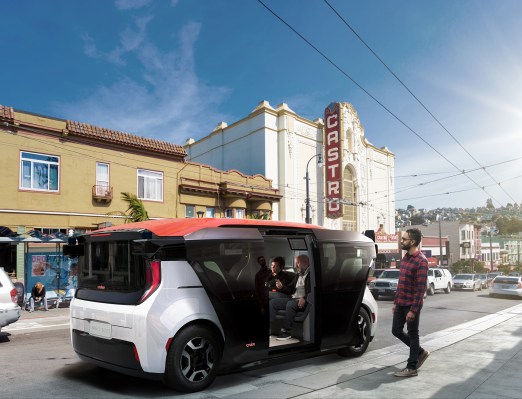GM’s Cruise pursuing permit to test its custom-built ‘Origin’ robotaxi in San Francisco

Cruise, GM’s self-driving technology subsidiary, has started the long and winding regulatory process to test its next-generation “Origin” robotaxi on public roads in San Francisco.
The company has applied for a permit with the California Department of Motor Vehicles to test its custom-built driverless vehicle on public roads. The news was first reported by The Wall Street Journal and confirmed to TechCrunch by Cruise.
Cruise is already charging the public for rides in its autonomous Chevy Bolt EVs in certain parts of San Francisco after receiving all the required permits from the California DMW and the California Public Utilities Commission.
But the Origin is a different automotive animal. The driverless Origin, the product of a multiyear collaboration with parent company GM and investor Honda that is designed for a ridesharing service, was unveiled in January 2020. The shuttle-like vehicle — branded with Cruise’s trademark orange and black colors — has no steering wheel or pedals and is designed to travel at highway speeds.
To test the Origin on public roads in California, Cruise will need permits from the California DMV, the primary agency regulating autonomous vehicle technology in the state. Cruise will also need permits from the CPUC to charge for a robotaxi service using the Origin vehicles.
Unlike its autonomous Chevy Bolt vehicles, the Origin will also need an exemption by the federal government to be used in a commercial ride-hailing service — once that day arrives.
The FAST Act, which was signed into law by President Obama in December 2015, allows manufacturers like GM to test and evaluate vehicles that might not otherwise meet federal motor vehicle safety standards (FMVSS). However, if Cruise wants to launch a commercial service — meaning charging for rides or delivery — with the Origin, it will need special exemptions from the National Highway Traffic and Safety Administration.
The Origin doesn’t meet a handful of federal motor vehicle safety standards (known as FMVSS) because it lacks certain parts like a steering wheel that are currently required in human-driven vehicles.
In February 2021, GM sent a request to the National Highway Traffic and Safety Administration for a temporary exemption from six FMVSS for its Origin vehicle. The exemptions are for several parts required in vehicles manufactured and sold in the United States. For instance, all vehicles must have windshield wiping and washing systems so human drivers can see the road clearly. Vehicles also must have a transmission shifter that follows a specific sequence for parking, reverse and drive. Since the Origin is designed without a human driver in mind, there is no physical transmission shifter.
A public comment period for the exemptions wrapped up in August 2022. NHTSA did not return a request for comment on when it is expected to issue its decision on the exemption.
Cruise has previously said it expects to begin production of the Origin in 2023, a date that gives some guidance on when the automaker expects to have an exemption and other permits that would allow it to ramp from testing to commercial operations.


